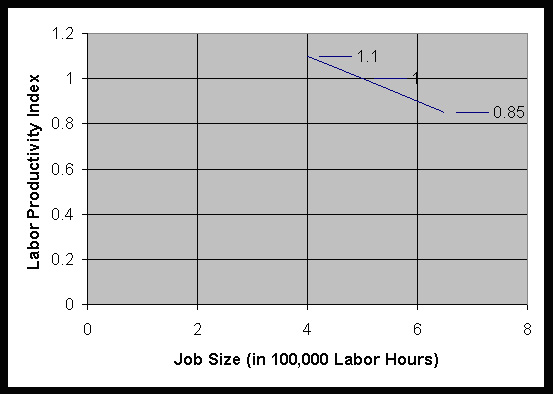H
Hugolina
Guest
Chapter 4 - Labor, Material and Equipment Utilization
4.1 Historical Perspective
Good project management in construction must vigorously pursue the efficient utilization of labor, material and equipment. Improvement of labor productivity should be a major and continual concern of those who are responsible for cost control of constructed facilities. Material handling, which includes procurement, inventory, shop fabrication and field servicing, requires special attention for cost reduction. The use of new equipment and innovative methods has made possible wholesale changes in construction technologies in recent decades. Organizations which do not recognize the impact of various innovations and have not adapted to changing environments have justifiably been forced out of the mainstream of construction activities.
Chương 4. Sử dụng nhân lực, vật tư và thiết bị
4.1. Bối cảnh lịch sử
Việc quản lý dự án tốt trong xây dựng phải bám chắc việc sử dụng nhân lực, vật tư và thiết bị một cách hiệu quả. Nâng cao năng suất lao động phải là mối quan tâm chính và thường xuyên của những nguời chịu trách nhiệm quản lý chi phí của các công trình xây dựng. Quản lý vật tư, gồm có mua sắm ngoài, quản lý kho, tự chế tạo và dịch vụ tại chỗ, yêu cầu sự quan tâm đặc biệt để có thể giảm chi phí. Việc sử dụng các thiết bị mới và các phương pháp hiện đại đã tạo ra sự thay đổi về khả năng bán buôn trong các công nghệ xây dựng ở những thập kỷ qua. Các tổ chức không nhận thức được sự tác động của những đổi mới về công nghệ và không thích ứng được với những môi trường luôn thay đổi đã bị loại ra khỏi trào lưu chính của các hoạt động xây dựng.
Observing the trends in construction technology presents a very mixed and ambiguous picture. On the one hand, many of the techniques and materials used for construction are essentially unchanged since the introduction of mechanization in the early part of the twentieth century. For example, a history of the Panama Canal construction from 1904 to 1914 argues that:
[T]he work could not have done any faster or more efficiently in our day, despite all technological and mechanical advances in the time since, the reason being that no present system could possibly carry the spoil away any faster or more efficiently than the system employed. No motor trucks were used in the digging of the canal; everything ran on rails. And because of the mud and rain, no other method would have worked half so well. [1]
Việc khảo sát các xu hướng trong công nghệ xây dựng cho thấy một bức tranh rất hỗn tạp. Một mặt, nhiều công nghệ và vật liệu sử dụng trong xây dựng về cơ bản là không thay đổi kể từ khi cơ giới hóa được đưa vào từ đầu thế kỷ XX. Ví dụ, một câu chuyện về việc xây dựng kênh đào Panama từ năm 1904 đến năm 1914 có viết:
Nếu ở thời chúng ta ngày nay, thì công việc cũng không thể thực hiện nhanh hơn hay hiệu quả hơn, cho dù từ đó đến này các tiến bộ về công nghệ và cơ khí đã tiến rất xa, lý do không hệ thống vận chuyển nào hiện nay có thể di dời đất thải nhanh và hiệu quả hơn hệ thống sử dụng thời đó. Người ta không sử dụng một chiếc ô tô tải nào trong việc đào kênh, tất cả đều dùng đường ray. Do bùn và mưa, không có biện pháp nào hiệu quả bằng một nửa biện pháp đó.
In contrast to this view of one large project, one may also point to the continual change and improvements occurring in traditional materials and techniques. Bricklaying provides a good example of such changes:
Bricklaying...is said not to have changed in thousands of years; perhaps in the literal placing of brick on brick it has not. But masonry technology has changed a great deal. Motorized wheelbarrows and mortar mixers, sophisticated scaffolding systems, and forklift trucks now assist the bricklayer. New epoxy mortars give stronger adhesion between bricks. Mortar additives and cold-weather protection eliminate winter shutdowns. [2]
Đối lập với quan điểm này của một dự án lớn, người ta cũng có thể chỉ ra những thay đổi liên tục và những cải tiến diễn ra trong vật liệu và kỹ thuật cổ truyền. Công tác xây gạch là một ví dụ hay về những thay đổi này:
Việc xây gạch….được coi là không có gì thay đổi trong hàng ngàn năm qua, có thể về nghĩa đen, việc đặt gạch chồng lên gạch là không thay đổi. Song công nghệ nề đã thay đổi rất nhiều. Xe cút kít gắn mô tơ và máy trộn vữa, các hệ thống giàn giáo hiện đại và xe xúc hiện đã trợ giúp cho công tác xây. Các loại vữa epoxy mới cho độ kết dính gạch tốt hơn. Các phụ gia cho vữa và bảo vệ chống thời tiết lạnh làm giảm thiểu việc sập vào mùa đông.
4.1 Historical Perspective
Good project management in construction must vigorously pursue the efficient utilization of labor, material and equipment. Improvement of labor productivity should be a major and continual concern of those who are responsible for cost control of constructed facilities. Material handling, which includes procurement, inventory, shop fabrication and field servicing, requires special attention for cost reduction. The use of new equipment and innovative methods has made possible wholesale changes in construction technologies in recent decades. Organizations which do not recognize the impact of various innovations and have not adapted to changing environments have justifiably been forced out of the mainstream of construction activities.
Chương 4. Sử dụng nhân lực, vật tư và thiết bị
4.1. Bối cảnh lịch sử
Việc quản lý dự án tốt trong xây dựng phải bám chắc việc sử dụng nhân lực, vật tư và thiết bị một cách hiệu quả. Nâng cao năng suất lao động phải là mối quan tâm chính và thường xuyên của những nguời chịu trách nhiệm quản lý chi phí của các công trình xây dựng. Quản lý vật tư, gồm có mua sắm ngoài, quản lý kho, tự chế tạo và dịch vụ tại chỗ, yêu cầu sự quan tâm đặc biệt để có thể giảm chi phí. Việc sử dụng các thiết bị mới và các phương pháp hiện đại đã tạo ra sự thay đổi về khả năng bán buôn trong các công nghệ xây dựng ở những thập kỷ qua. Các tổ chức không nhận thức được sự tác động của những đổi mới về công nghệ và không thích ứng được với những môi trường luôn thay đổi đã bị loại ra khỏi trào lưu chính của các hoạt động xây dựng.
Observing the trends in construction technology presents a very mixed and ambiguous picture. On the one hand, many of the techniques and materials used for construction are essentially unchanged since the introduction of mechanization in the early part of the twentieth century. For example, a history of the Panama Canal construction from 1904 to 1914 argues that:
[T]he work could not have done any faster or more efficiently in our day, despite all technological and mechanical advances in the time since, the reason being that no present system could possibly carry the spoil away any faster or more efficiently than the system employed. No motor trucks were used in the digging of the canal; everything ran on rails. And because of the mud and rain, no other method would have worked half so well. [1]
Việc khảo sát các xu hướng trong công nghệ xây dựng cho thấy một bức tranh rất hỗn tạp. Một mặt, nhiều công nghệ và vật liệu sử dụng trong xây dựng về cơ bản là không thay đổi kể từ khi cơ giới hóa được đưa vào từ đầu thế kỷ XX. Ví dụ, một câu chuyện về việc xây dựng kênh đào Panama từ năm 1904 đến năm 1914 có viết:
Nếu ở thời chúng ta ngày nay, thì công việc cũng không thể thực hiện nhanh hơn hay hiệu quả hơn, cho dù từ đó đến này các tiến bộ về công nghệ và cơ khí đã tiến rất xa, lý do không hệ thống vận chuyển nào hiện nay có thể di dời đất thải nhanh và hiệu quả hơn hệ thống sử dụng thời đó. Người ta không sử dụng một chiếc ô tô tải nào trong việc đào kênh, tất cả đều dùng đường ray. Do bùn và mưa, không có biện pháp nào hiệu quả bằng một nửa biện pháp đó.
In contrast to this view of one large project, one may also point to the continual change and improvements occurring in traditional materials and techniques. Bricklaying provides a good example of such changes:
Bricklaying...is said not to have changed in thousands of years; perhaps in the literal placing of brick on brick it has not. But masonry technology has changed a great deal. Motorized wheelbarrows and mortar mixers, sophisticated scaffolding systems, and forklift trucks now assist the bricklayer. New epoxy mortars give stronger adhesion between bricks. Mortar additives and cold-weather protection eliminate winter shutdowns. [2]
Đối lập với quan điểm này của một dự án lớn, người ta cũng có thể chỉ ra những thay đổi liên tục và những cải tiến diễn ra trong vật liệu và kỹ thuật cổ truyền. Công tác xây gạch là một ví dụ hay về những thay đổi này:
Việc xây gạch….được coi là không có gì thay đổi trong hàng ngàn năm qua, có thể về nghĩa đen, việc đặt gạch chồng lên gạch là không thay đổi. Song công nghệ nề đã thay đổi rất nhiều. Xe cút kít gắn mô tơ và máy trộn vữa, các hệ thống giàn giáo hiện đại và xe xúc hiện đã trợ giúp cho công tác xây. Các loại vữa epoxy mới cho độ kết dính gạch tốt hơn. Các phụ gia cho vữa và bảo vệ chống thời tiết lạnh làm giảm thiểu việc sập vào mùa đông.
Last edited by a moderator:












































